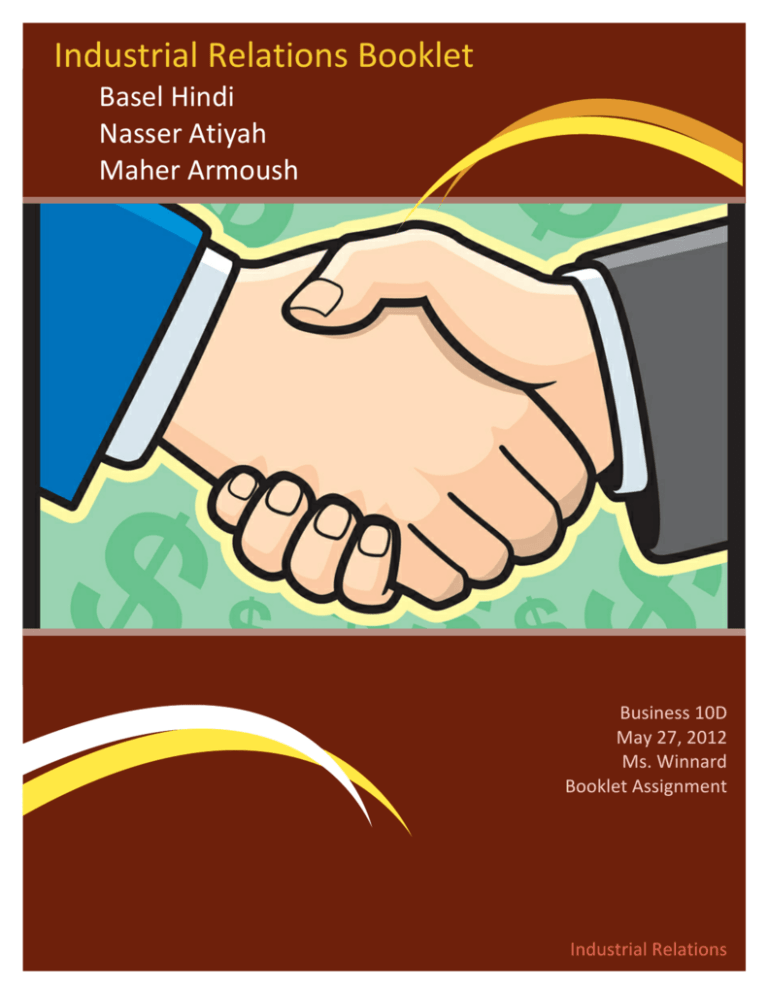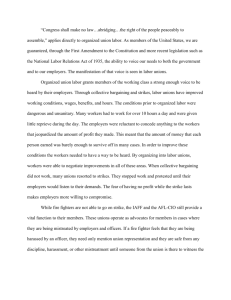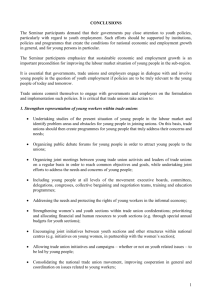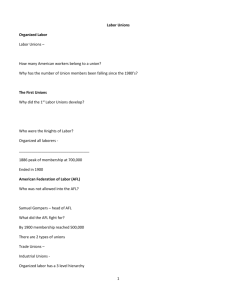Industrial Relations Booklet
advertisement

Industrial Relations Booklet Basel Hindi Nasser Atiyah Maher Armoush Business 10D May 27, 2012 Ms. Winnard Booklet Assignment Industrial Relations Trade Unions What Is a Trade Union A trade union is an organization set up by workers that have joined together in order to achieve the same overarching goal. Such goals include; enforcing higher wage standards for employees, increasing the number of employees an employer can hire and improving the working conditions. The trade union through its leaderships, bargains with the worker’s employers on the behalf of the employees themselves and negotiates labor contracts with them. The most common purpose of trade unions is to improve and maintain the working conditions of the employees. Trade Unions § What Is a Trade All sorts of jobs are covered by trade unions, whether they have a general profession or a specific on. For example, the National Union of Journalists (NUJ), as its name suggests, represents journalists, and the Union for Finance Staff (UNIFI) is made up of people who do different jobs in the financial sector. What Are the What are the Benefits to Members Union? § The trade union may also take on the negotiation of issues such as: salaries, on-­‐ job rules, complaint procedures, recruitment policies, firing and promotion of workers and employee benefits. The agreements negotiated by the union leaders are binding on the rank and file members and the employer and in some cases on other non-­‐member workers. Benefits of a Trade Union to Members? which include the following. The representatives for the employees can negotiate with § What Are the Benefit of a Trade Union to Employers? employers to improve conditions of employment, rates of pay, holidays, hours of work, also they could also negotiate improving the environment in which employees work in. This will then make the employees have better job satisfaction and will feel that they are being treated fairly, which will then make the progress in the business better. Also if employees come together and join this union it will encourage the employers to accept § Becoming a member of a trade union provides many benefits and advantages, What Are the Different Types of Trade Unions? what they demand because of the amount of people, if only one employee comes and states his demands it will be easier for the business employers to refuse. Another benefit is that it will provide additional support to employee’s to come and seek advice if they think that they have been dismissed unfairly, etc. Finally joining a trade union will also have a representative that will negotiate the additional benefits such as discounts at certain shops, having facilities for employees to use, etc. As you can see there are many benefits provided for employees/members of a trade union. Industrial Relations Trade Unions How Do Trade Unions Benefit Employers? There are many benefits of a trade union to the employer. Firstly, the employees will have stronger commitment to the workplace, meaning that there will be less costs being spent on recruitment and employee turnover. Secondly, employees feel weak or without power when their voice is not heard and nothing is changed when necessary, which is the reason why more commitment will be found from the employees after trade unions are formed. Thirdly, businesses find it very easy to plan out all costs for salaries for the next 3-­‐5 years (which is common in trade union contracts), which makes developing plans for costs more accurate. Lastly, employee discipline will become very strict, as employees will feel fully satisfied with their jobs, and will be afraid to lose them. This will prevent strikes, increase production, and increase efficiency and product quality. Trade Unions § What Is a Trade Union? § What Are the Benefits of a Trade Union to Members? § What Are The Different Types of Trade Unions? Craft Unions: Craft unions are the oldest type of trade unions out there; they were descended from the guilds of middle-­‐evil Europe. Craft unions represent people that have the same professions (etc. doctors, engineers) or crafts and perform the same type of job. Craft unions have been known for their conservative methods, concerning both, social and political matters. What makes craft unions different than other trade unions, is that they generally only work with skilled professionals. Examples of craft unions include building trade unions, plumbers, boilermakers and operating engineers. A Craft union is an example of horizontal organizing. What Are the Benefit of a Industrial Unions: Trade Union to of Trade Industrial unions organize people coming from the same industry, regardless of their profession. Industrial unions rose to fame in the United States and other European countries during the time of the great depression. Industrial unions are generally more politically liberal than craft unions. Advocates of industrial unions focus on/value building unity and solidarity, resulting in having slogans similar to, " An injury to one is an injury to all " and "the longer the picket line, the shorter the strike." Examples of global industrial unions are: Industrial workers of the world, international Trade Union Confederation, International Workers Association, World Federation. Unions? Employers? § What Are the Different Types Industrial Relations Trade Unions Trade Unions Types: Continued Syndicalist Unions: Trade Unions § What Is a Trade Union? § What Are the Benefits of a Trade Union to Members? § What Are the The Labor Relations Act passed by the Roosevelt Administration during the Great Depression essentially barred company unions. However, company unions are still being used till this day in a form that has been slightly changed from the past. Company unions generally take the form of employee organizations within companies that are experiencing unionization drives. The term "company union" is not necessarily pejorative; however, the synonymous term "yellow union" is. Trade Union to General Union: Employers? A General Union is a trade union, which represents workers from all industries and companies, rather than just one organization or a particular sector, as in a craft union or industrial unions. A general union differs from a union federation or trades council in that its members are individuals, not unions. What Are the Different Types Unions? The creation of general unions, from the early nineteenth century in the United Kingdom and somewhat later elsewhere, occurred around the same time as efforts began to unionize workers in new industries, in particular those where employment could be irregular. of Trade Industrial Relations Company Unions: Benefit of a § Syndicalist unions don't have much presence in the United States anymore. However, they continue to carry some sway in certain parts of Europe and were a driving force of the labor movement in the early part of the 20th century. Syndicalist unions seek to organize workers into one union representing all workers. They generally have a very liberal political bent, going as far as anarchism (belief in the abolition of all government and the organization of society on a voluntary, cooperative basis without recourse to force or compulsion). Syndicalist unions also seek to eradicate the wage system, as they consider it to be wage slavery. Furthermore they also ask to put a stop to the ownership of the means of production; as it results in having class divisions. The Industrial Workers of the world aren't the powerful force in the labor movement they were in the early 20th century, but they still exist. Sweden, France and Spain currently have notable syndicalist unions. Two Examples of Trade Unions American Federation of Labor (AFL) : Transport and General Workers’ Union (TGWU): Established in 1886, the American Federation of Labor is an umbrella organization for other unions. Largest general trade union in Great Britain throughout much of the 20th century. It originated In 1881, Samuel Gompers took the lead in organizing the Federation of Organized Trades and Labor Unions of the United States of America and Canada. This organization became the American Federation of Labor (AFL) in 1886, in Columbus, Ohio. Many members of these two groups were disgruntled members of the Knights of Labor, the most influential organization of unions in the United States during the 1870s. Gompers served as the AFL's first president. He remained the organization's president, other than for one year, until his death in 1924. Under Gompers's leadership, the AFL became the largest labor union organization in the United States. The AFL initially allowed only skilled workers to join the organization. Unskilled laborers initially did not have representation under the AFL. The group also originally prohibited women, African Americans, and other racial minorities from joining the organization. Gompers supported the use of strikes, but he preferred peaceful negotiations to attain fair contracts for workers from their employers. He also sought to keep the AFL out of the political arena, believing that political activity might offend some business owners and hinder the workers' ability to attain better conditions. in 1889 with the formation of the Dockers’ Union. By 1904, the American Federation of Labor had 1.7 million members. The organization's membership soared during World War I, as the federal government granted numerous concessions to workers and unions. As the United States was engaged in a world war, the government hoped to avoid strikes by intervening on the behalf of workers with their employers. In 1920, AFL membership had soared beyond four million workers. Unfortunately for the AFL, the 1920s and 1930s resulted in new difficulties for the organization and its leadership. Some members began to call for a more inclusive organization -­‐-­‐ one that would fight for the rights of unskilled workers as well, rather than just workers skilled in a particular craft. Tensions over this issue became so prevalent that, in 1935, John L. Lewis, an AFL member, formed the Committee for Industrial Organization. Originally, this organization was a part of the AFL, but in 1937, the parent organization expelled all members of the Committee for Industrial Organization. The Committee for Industrial Organization eventually became the Congress of Industrial Organizations (CIO). The AFL and the CIO remained as two separate organizations until 1955, when the two groups reunited together as the AFL-­‐CIO. semiskilled and unskilled workers, especially in For the remainder of the twentieth century, the AFL-­‐CIO remained the largest union organization in the United States. The percentage of unionized workers, however, declined beginning in the 1950s. In 1953, 32.5% of American workers were union members. By 1983, only twenty percent of American workers belonged to a union. In 1922 that union led the merger of 14 unions to form an organization representing more than 300,000 workers. Tony Woodly is a dominant factor to TGWU formation and improvement, the union’s first general secretary (1922–40). As a general union, the TGWU maintained a policy of enrolling workers who had been excluded by the rigid requirements of the craft unions. As a result, the TGWU underwent remarkable growth, with membership exceeding two million in the 1970s. Members came from nearly all of the transportation industries (except railroads) and from automobile, construction, chemical, textile, and other industries. By organizing both smaller manufacturing trades, the general unions such as the TGWU represented workers traditionally ignored by the craft unions and industrial unions. TGWU is an affiliation of four other unions: Trades union congress TUC, Scottish Trade Unions Congress STUC, International Transport Workers’ Federation ITF, International Union of Food, Agricultural, Hotel, Restaurant, Catering, Tobacco and Allied Workers' Association IUF. In recent years, however, the TGWU and other British trade unions have experienced significant declines in membership and influence as members have dropped down to 800,000 in 2006. Collective Bargaining What Is Collective Bargaining? Collective Bargaining What Is It? How Does It Work § § What Are The Benefits of Using Collective Bargaining? Collective Bargaining is the process in which negotiations are made between the employees of a business and the employers of the business towards certain aspects such as improving working conditions like hours of work and working environments, employment conditions such as health and benefits, and pay/salaries for the workers. The employee’s representative or leader of trade union usually makes the negotiations, with the employers or their representatives. It allows workers to be able to express their reasonable thoughts and opinion’s regarding their employment to that company, so that they will feel fairly treated while working at the company. Supposedly both the employee and the employer have different views towards the employment of the business, the employer wants to have the maximum work done and pay less for it in order to increase revenue or profits, while the employee wants more pay for less work. But both of these thoughts are unfair to either side, so in order to satisfy both the employee and the employer they both must come to a fair agreement. When they finally come to an agreement, a contract will be issued called “The Collective Bargaining Agreement” that will show all negotiation aspects with their agreed result towards each. How Does Collective Bargaining Work? Both the employees and the employers must follow certain steps in order to fulfill the Collective Bargaining process. First the Employees must form a trade union in which they can discuss and plan the points they need to be changed or negotiated with the employer, therefore this will make it much easier for the employer to listen and respond to the employees needs. At the same time the employers get together and also decide on points that they would like to negotiate with the employees in regards to working conditions like hours of work and working environments, employment conditions such as health and benefits, and pay/salaries for the workers. Once this planning stage is complete each side should select a representative that will discuss their points with the other. There will be rules set on how to bring up points at the meeting. Once this is complete the two representatives from both sides will layout there points just to see if there are some that don’t need to be negotiated, or both already agree. Know that the identifying period is complete each side will discuss in depth each point they have on there lists and negotiate accordingly. Here the two sides can argue and negotiate they’re reasoning behind there decisions. Both should aim for the fairest path to satisfy both the employee and employer. And sometimes not all points come to an agreement, which may force the employees to take industrial action. Once the representatives for the employees and the employers have come to a agreement on the points, they will then issue a Collective Bargaining Agreement that will state the results for the negotiated points. Industrial Relations Collective Bargaining What are the Benefits of Collective Bargaining? Collective Bargaining • What Is It? How Does It Work • What Are The Benefits of Using Collective Bargaining? Industrial Relations Using Collective Bargaining provides many benefits to both the employees and the employers of that business. One major benefit is that the employees will feel that they are being treated fairly and will have a better incentive to work thus increasing efficiency and progress in the businesses work. Also with the more motivated employees there will be less money spent on recruitment since there will be less cases of employees leaving/quitting there jobs, and there will be less industrial action taken by these employees that can include strikes and refusing to work until they receive there reasonable demands, and there will be more industrial peace throughout the working area. At the same time the employers as will feel happy that both have gained something. There will also be a better side to employment relations between the employees and the employer. Industrial Action: Industrial Action Examples: 1. Picketing: Picketing is carried out to support strike action. Workers who are striking stand outside of the factory gates and try to persuade other employees to stop working for a specific period of time. If the employees are successful then the production of the company may be stopped altogether, putting pressure on the employer to come to an agreement with the employees. 2. Work to Rule: The work to rule technique of industrial action would be where the employees decide to stick rigidly to the rulebook of the business. This technique normally takes place in businesses where many checks or tests should be done on the product before release. Normally these checks will take a very large amount of time to complete, which is why owners will encourage the employees to skip some tests in order to increase production rates. Using the work to rule technique, the employees complete all checks, no matter how time consuming in order to receive full salary (as they are not breaking any rules), while disrupting the production rates. 3. Non-­‐Cooperation: Non-­‐Cooperation is when employees refuse to have anything to do with new practices in the business. For example, if a new administration procedure were passed, making employees fill more paperwork, the employees would refuse to complete any of the new forms. 4. Overtime Ban: An overtime ban is when trade union members only carry out their duties and workloads during normal hours of work. Employees refuse o do any additional work after hours, which can be very damaging to a business that needs to complete an order quickly. The employees still receive normal salaries, but they do not gain any overtime pay. Industrial Action Industrial Relations ACAS-­‐UK Organization What Do The Letters Represent The letters in the “ACAS” organization represent: “Advisory, Conciliation and Arbitration Service”. The word Advisory means providing advise, the word Conciliation means bringing disputing sides together, and Arbitration service means the process of solving disputes usually through negotiation. What Does ACAS Do? “ACAS” or “Advisory, Conciliation and Arbitration Service” is an organization that is situated in the United Kingdom that specializes in “improving organizations and working life through employment relations”. (source) This organization does not take either the employee or the employer’s side there basically there to aid both in coming to an agreement. ACAS benefits both employers and employees by helping them solve disputes and will therefore improve the performance of work done in the business. This organization was founded in the year 1975; they also provide their services free to make it even more convenient for businesses. ACAS-­‐UK Organization Industrial Relations Pressure Groups Definition: Why Might Trade Unions be classified as Pressure Groups? § Definition Pressure Groups A pressure group is a group of people who share a common aim or interest, and are willing to take action to try to change the opinions of government policies or business decisions. The term pressure groups refers to a very wide variety of groups, including huge associations which represent thousands of businesses, and small local groups who try to solve smaller problems. A pressure group will not try to gain power to change legislations, but to influence the opinions of decision makers such as business CEO’s, or government leaders to achieve their aim. A great example of a pressure group would be Greenpeace, who publicize the damaging activities of some businesses on the environment in hopes of influencing the passing of legislation to stop these damages, or to influence the business to stop damaging the environment. § Why Might Trade Unions be classified as Pressure Groups? Trade Unions and Pressure Groups have many common aspects, which is the precise reason why they may be classified as one another. Specifically, both Trade Unions and Pressure Groups try to influence the decisions of governments and leaders (of businesses, companies, or areas) in order to attain the goal of helping a group of people, animals, or the environment. Both Trade Unions and Pressure Groups work in very similar manners, where employees, or groups of concerned citizens peacefully protest on a certain subjects in the hopes of influencing decision makers to attain a goal (such as providing homeless shelters, or passing legislations on businesses to develop pollution-­‐free production). Generally, trade unions are commonly knows as a type of pressure group due to their similarities in goals and the techniques used to achieving them. Industrial Relations Activities and Games: Activities and Games: Bibliography: • "Trade Union." Wikipedia. Wikimedia Foundation, 25 May 2012. Web. 26 May 2012. <http://en.wikipedia.org/wiki/Trade_union>. • "Biz/ed -­‐ TUC Company Facts Home Page | Biz/ed." Biz/ed -­‐ TUC Company Facts Home Page | Biz/ed. Web. 26 May 2012. <http://www.bized.co.uk/compfact/tuc/tucindex.htm?page=12>. • Pell, Nicholas. "Types of Labor Unions." Ehow. Web. 26 May 2012. <http://www.ehow.com/list_6324843_types-­‐labor-­‐unions.html>. • "Labor Unions." Enotes.com. Enotes.com. Web. 26 May 2012. <http://www.enotes.com/labor-­‐unions-­‐ reference/labor-­‐unions-­‐174357>. • "General Union." Wikipedia. Wikimedia Foundation, 21 May 2012. Web. 26 May 2012. <http://en.wikipedia.org/wiki/General_union>. • "Transport and General Workers' Union (TGWU) (British Trade Union)." Encyclopedia Britannica Online. Encyclopedia Britannica. Web. 26 May 2012. <http://www.britannica.com/EBchecked/topic/603088/Transport-­‐and-­‐General-­‐Workers-­‐Union-­‐TGWU>. • "American Federation of Labor." -­‐ Ohio History Central. Web. 26 May 2012. <http://www.ohiohistorycentral.org/entry.php?rec=835>. • "Importance Of Collective Bargaining." Industrial Relations. Web. 26 May 2012. <http://industrialrelations.naukrihub.com/importance-­‐of-­‐collective-­‐bargaining.html>. • "Collective Bargaining." Collective Bargaining. Web. 26 May 2012. <http://www.ilo.org/global/standards/subjects-­‐covered-­‐by-­‐international-­‐labour-­‐standards/collective-­‐ bargaining/lang-­‐-­‐en/index.htm>. • "What We Do." Home. Web. 26 May 2012. <http://www.acas.org.uk/index.aspx?articleid=1461>. • "The Collective Bargaining Process." [Mackinac Center]. Web. 26 May 2012. <http://www.mackinac.org/8274>. • "Collective Bargaining Real People. Real Impact." Collective Bargaining. Web. 26 May 2012. <http://www.collectivebargainingfacts.org/>. • Smith, S.E., and Bronwyn Harris. "What Is Collective Bargaining?" WiseGeek. Conjecture, 13 Feb. 2012. Web. 26 May 2012. <http://www.wisegeek.com/what-­‐is-­‐collective-­‐bargaining.htm>. • "Benefits of Collective Bargaining." Benefits of Collective Bargaining. Web. 26 May 2012.<http://www.twuskywest.org/WhyAUnion/BenefitsofCollectiveBargaining/tabid/1063/Default.aspx>. • Xaxx, Jagg. "Advantages & Disadvantages of Collective Bargaining." EHow. Demand Media, 21 Mar. 2011. Web. 26 May 2012. <http://www.ehow.com/info_8090430_advantages-­‐disadvantages-­‐collective-­‐ bargaining.html>.








